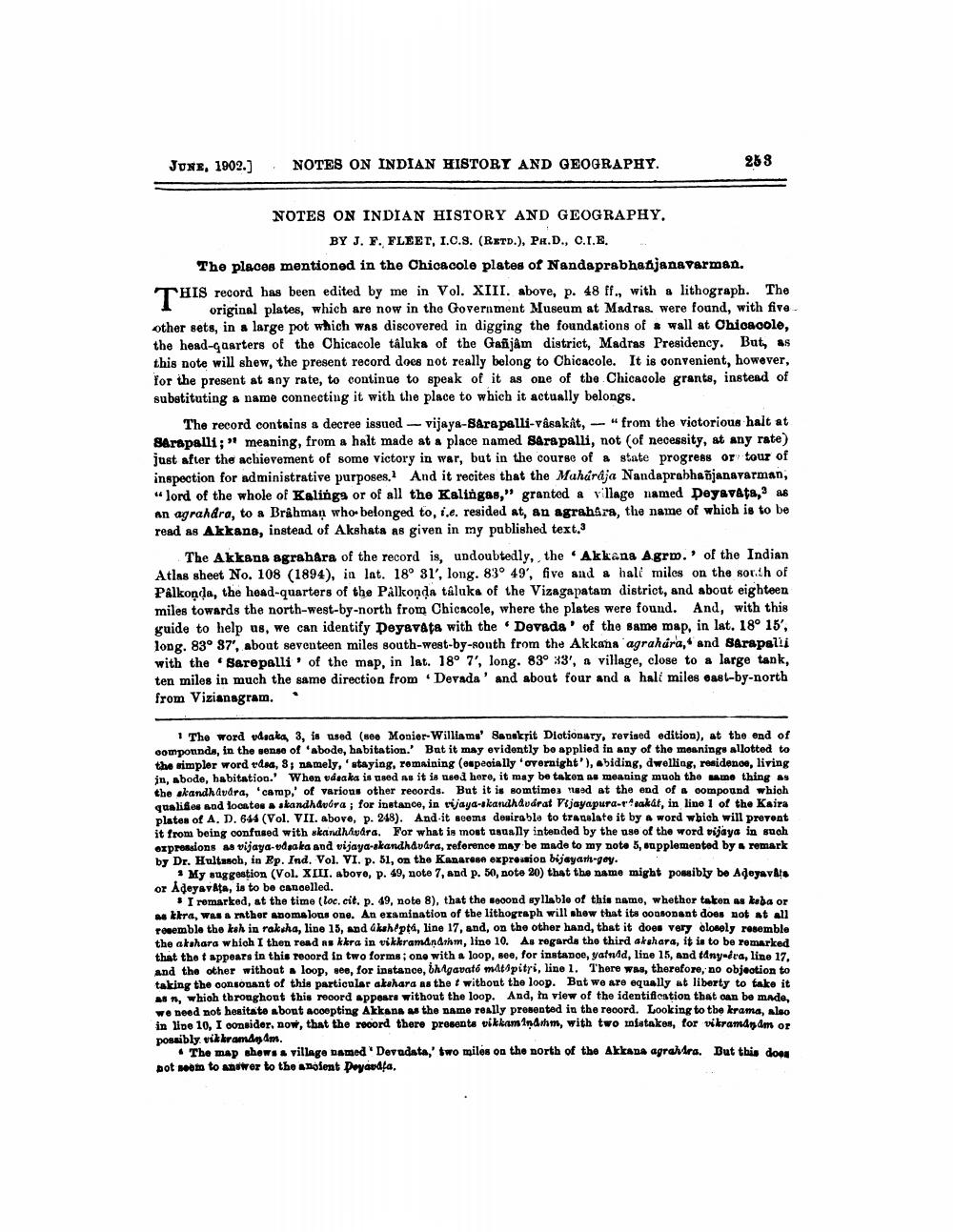________________
JUNE, 1902.)
NOTES ON INDIAN HISTORY AND GEOGRAPHY.
258
NOTES ON INDIAN HISTORY AND GEOGRAPHY.
BY J. F. FLEET, I.C.S. (RETD.), Ph.D., C.L.E. The places mentioned in the Chicacole plates of Nandaprabhanjanavarman. THIS record has been edited by me in Vol. XIII. above, p. 48 ff., with a lithograph. The
original plates, which are now in the Government Museum at Madras. were found, with five other sets, in a large pot which was discovered in digging the foundations of wall at Ohioacole, the head-aarters of the Chicacole taluka of the Gañjam district, Madras Presidency. But, as this note will shew, the present record does not really belong to Chicacole. It is convenient, however, for the present at any rate, to continue to speak of it as one of the Chicacole grants, instead of substituting a name connecting it with the place to which it actually belongs.
The record contains a decree issued - vijaya-8&ra palli-âsakat, " from the victorious halt at SArapalli; " meaning, from a halt made at a place named Sarapalli, not (of necessity, at any rate) just after the achievement of some victory in war, but in the course of a state progress or tour of inspection for administrative purposes. And it recites that the Mahárdja Nandaprabhañjanavarman,
lord of the whole of Kalings or of all the Kalingas," granted a village named Deyavata, as an agrahdra, to a Brahman who belonged to, i.e. resided at, an agrahara, the name of which is to be read as Akkana, instead of Akshata as given in my published text.
The Akkana agrahara of the record is, undoubtedly, the Akkana Agrm.' of the Indian Atlas sheet No. 108 (1894), in lat. 18° 31', long. 83° 49', five and a hali miles on the south of Palkonda, the head-quarters of the Palkonda taluka of the Vizagapatam district, and about eighteen miles towards the north-west-by-north from Chicacole, where the plates were found. And, with this guide to help us, we can identify Deyavata with the Devada' of the same map, in lat. 18° 15', long. 83° 87', about seventeen miles south-west-by-south from the Akkana agrahara, and Sarapalli with the Sarepalli' of the map, in lat. 18° 7', long. 83° 33', a village, close to a large tank, ten miles in much the same direction from Devada' and about four and a hali miles east-by-north from Vizianagram.
1 The word viiaks, 3, is used (see Monier-Williams' Sanskrit Dictionary, revised edition), at the end of componnds, in the sense of abode, habitation. But it may evidently be applied in any of the meanings allotted to the simpler word edua, 8; namely,' staying, remaining (especially overnight'), abiding, dwelling, residence, living in, abode, habitation. When vaaka is used as it is used here, it may be taken as meaning muoh the same thing as the skandhavdra, 'camp, of various other records. But it is somtimea uad at the end of a compound which qualifies sad locates kandh de
e, in vijaya-skandidudrat Vijayapura-rakat, in line 1 of the Kaira plates of A. D. 644 (Vol. VII. above, p. 248). And it seems desirable to translate it by word wbich will prevent it from being confused with skandh Andra. For what is most usually intended by the use of the word vijaya in such expressions as vijaya-edsaka and vijaya-skandhavára, reference may be made to my note 5, supplemented by remark by Dr. Hultanch, in Ep. Ind. Vol. VI. p. 51, on the Kanarese expression bijayath-goy.
My suggestion (Vol. XIII. above, p. 49, note 7, and p. 50, note 20) that the name might possibly be Adegavate Or Adeyay ata, is to be cancelled.
I romarked, at the time (loc. cit. p. 49, note 8), that the second syllable of this namo, whethor taken as kaba or kkra. WAS A rather anomalous one. An examination of the lithograph will show that its 00sonant does not at all resemble the ksh in raksha, line 15, and Ukshepta, line 17, and, on the other hand, that it does very closely resemble the akshara which I then read as kkra in vikkramandim, line 10. As regards the third akshara, it is to be remarked that the t appears in this rooord in two forms; one with a loop, see, for instanoe, yanid, line 15, and tany-dra, line 17. and the other without a loop, se, for instance, thAgavató mitspitri, line 1. There was, therefore, no objetion to taking the consonant of this particular akshara as the t without the loop. But we are equally at liberty to take it an, which throughout this rooord appears without the loop. And, to view of the identification that can be made, we need not hesitate abont accepting Akkans as the name really presented in the record. Looking to the krama, also in lide 10, I consider, now, that the record there presents vikkam Indsm, with two mistakes, for vikramdam or possibly, vikramdam.
• The map shows village damed 'Doradata,' two miles on the north of the Akkada agraira. But this does pot seem to answer to the Anoient Dryapdfa.




